Home » Chinese Culture » The Most Famous Chinese dishes and Recipes
Taste the Best of China
China is renowned for its rich and diverse cuisine, with a wide array of flavors, textures, and aromas that have captivated the palates of people all over the world. From fiery Sichuan dishes to delicate Cantonese cuisine, there is something for everyone to savor in China’s culinary landscape. Among the most famous dishes that have emerged from this gastronomic paradise are classics such as succulent Peking duck, spicy Sichuan-style mapo tofu, and tender Dongpo pork. Whether you’re a seasoned foodie or simply someone who loves to explore new tastes and cultures, China’s culinary treasures are sure to tantalize your taste buds and leave you craving for more. Join us on a journey to discover the top 20 most famous dishes in China, each with its own unique history, flavors, and stories to tell.
China's 20 most famous dishes and recipes
1. Peking Duck (北京烤鸭)
Origin & History:
Peking Duck is a world-renowned Chinese dish that has its origins in the imperial courts of ancient China, dating back over a thousand years. It was initially prepared for the imperial family during the Yuan Dynasty but gained widespread popularity during the Ming Dynasty. The dish is named after the capital city of China, Beijing (formerly known as Peking), where it was perfected and became a symbol of Chinese culinary excellence. Today, Peking Duck is enjoyed by people all around the world for its exquisite taste and presentation.
Features & Preparation:
Peking Duck is famous for its incredibly crispy skin and tender, flavorful meat. The dish is prepared using a whole duck, which is marinated and seasoned with a blend of spices, such as star anise, ginger, and cinnamon. The duck is then roasted in a specialized oven, which allows the skin to become crispy and golden while the meat remains juicy and tender. The preparation process can be quite elaborate and time-consuming, often taking up to 24 hours to complete.
Once the duck is roasted to perfection, it is traditionally presented whole at the table and then skillfully carved by the chef. The crispy skin and succulent meat are typically served with thin pancakes, julienned cucumber, spring onions, and hoisin sauce. Diners assemble their own Peking Duck “wraps” by spreading a thin layer of hoisin sauce on the pancake, adding pieces of duck, cucumber, and spring onions, and then rolling the pancake into a small, handheld wrap.
To prepare Peking Duck at home, begin by marinating a whole duck in a mixture of spices, such as star anise, ginger, and cinnamon, as well as other flavorings like soy sauce and sugar. Allow the duck to marinate for at least 24 hours. Next, roast the duck in an oven at a high temperature to achieve the desired crispy skin and tender meat. While the duck is roasting, prepare the accompaniments: thin pancakes, julienned cucumber, spring onions, and hoisin sauce. Once the duck is cooked, carve it into thin slices, and serve with the prepared accompaniments.
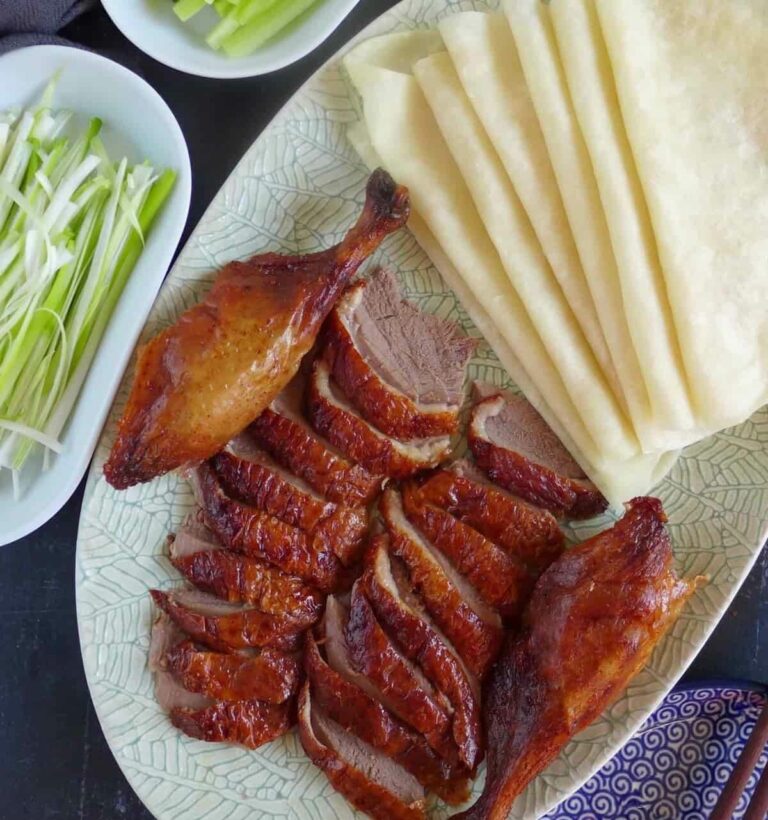
Image Source
2. Yunnan Wild Mushroom Hot Pot (云南野生菌火锅)
Origin & History:
Yunnan Wild Mushroom Hot Pot is a traditional Chinese dish that hails from Yunnan Province, a region known for its incredible biodiversity and abundance of wild mushrooms. The diverse range of mushrooms found in Yunnan, including matsutake, porcini, and morel, contribute to the unique and rich flavors of this hot pot dish. The Yunnan Wild Mushroom Hot Pot has a long history, with its roots tracing back to the indigenous cultures that have been harvesting and utilizing these mushrooms for centuries.

Image Source
Features & Preparation:
Known for its earthy flavors and variety of textures, this hot pot features a flavorful broth made with chicken or pork bones and a medley of Yunnan’s wild mushrooms. Additional ingredients like tofu, leafy greens, and thinly sliced meats are cooked in the simmering broth.
To prepare, make the broth by simmering bones or meat with ginger, garlic, and green onions. Simmer for several hours, then clean and slice mushrooms and other ingredients. Strain the broth into a hot pot and place over a portable stove. Arrange mushrooms, meats, and vegetables on a serving platter. Provide a small strainer or slotted spoon for guests to cook ingredients in the broth. Enjoy cooked ingredients with a dipping sauce made from soy sauce, sesame oil, and minced garlic or chili. Yunnan Wild Mushroom Hot Pot is a delicious, warming, and interactive dining experience.
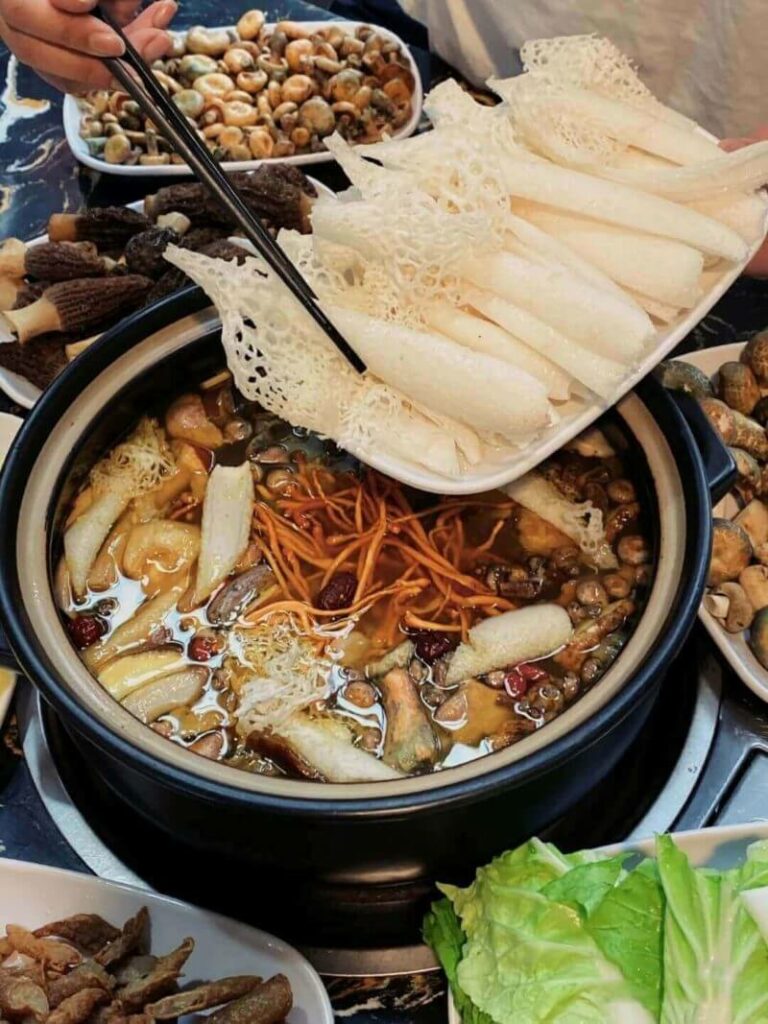
Image Source : CielYunnan
3. Spicy Crawfish (麻辣小龙虾)
Origin & History:
Spicy Crawfish, also known as “Mala Xiaolongxia” in Chinese, is a popular and mouthwatering dish that originated in the southern regions of China. The dish became particularly popular in the 1990s and has since spread throughout the country, becoming a staple in both restaurants and street food markets. The popularity of Spicy Crawfish has grown immensely in recent years due to its irresistible flavors and unique dining experience, and it has now become a beloved dish for food enthusiasts both in China and around the world.
Features & Preparation:
Spicy Crawfish is known for its bold and fiery flavors, which are characteristic of Sichuan cuisine. The dish features fresh crawfish that are cooked in a spicy and aromatic sauce made from a blend of ingredients, such as chili peppers, Sichuan peppercorns, garlic, ginger, and various spices. The sauce not only infuses the crawfish with its intense flavors but also provides a mouth-numbing sensation, which is a hallmark of Sichuan cuisine. Spicy Crawfish is typically served with a variety of side dishes, such as corn, potatoes, and lotus root, which help to balance the dish’s intense heat.
To prepare Spicy Crawfish, start by cleaning and rinsing the fresh crawfish thoroughly. In a large pot or wok, heat oil and stir-fry a mixture of chili peppers, Sichuan peppercorns, garlic, and ginger until fragrant. Add the crawfish to the pot, stirring to coat them evenly in the spice mixture. Pour in a mixture of water or chicken broth and various seasonings, such as soy sauce, sugar, and spices, and bring to a boil. Once boiling, reduce the heat and simmer the crawfish until they are cooked through and have absorbed the flavors of the sauce.
In a separate pot, cook the side dishes, such as corn, potatoes, and lotus root, until tender. Add the cooked side dishes to the Spicy Crawfish, allowing them to soak up some of the sauce’s flavors. Once everything is cooked and combined, transfer the Spicy Crawfish and side dishes to a large serving platter.
Spicy Crawfish is typically enjoyed as a communal dining experience, with friends and family gathered around the table, using their hands to peel and savor the flavorful crawfish. Be prepared for a delicious and interactive meal that is sure to delight your taste buds and leave a lasting impression.
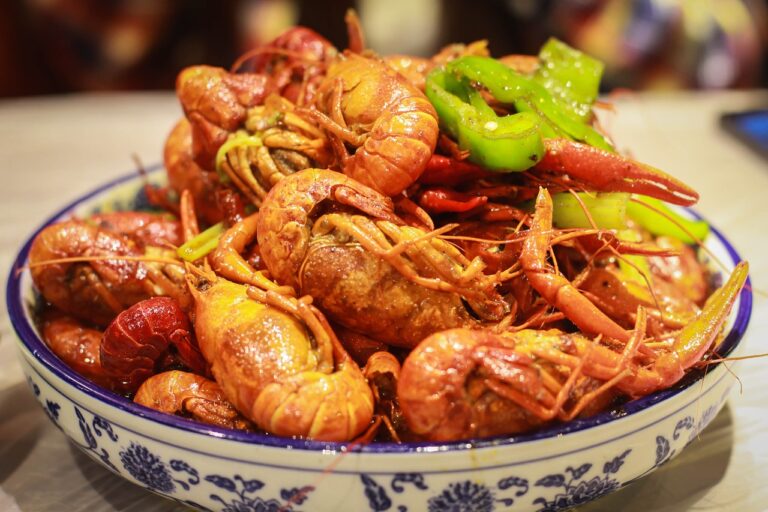
4. Mapo Tofu (麻婆豆腐)
Origin & History:
Mapo Tofu is a well-known and beloved Sichuan dish that has a rich history dating back to the Qing Dynasty. The dish is named after its creator, a woman with a pockmarked face who ran a small restaurant in Chengdu, the capital city of Sichuan Province. “Ma” means pockmarked, “po” refers to a woman, and “doufu” is tofu in Chinese, hence the name “Mapo Tofu.” The dish became popular for its bold and spicy flavors, and over time, it spread throughout China and eventually gained international recognition.
Features & Preparation:
Mapo Tofu is celebrated for its unique combination of flavors and textures. The dish consists of soft, silken tofu and minced meat, usually pork or beef, cooked in a spicy, flavorful sauce. The sauce is made from a combination of fermented broad bean paste (doubanjiang), fermented black beans (douchi), chili oil, Sichuan peppercorns, garlic, ginger, and green onions, which provide a complex and satisfying taste. The dish is often garnished with additional green onions and a sprinkle of ground Sichuan peppercorns for an extra numbing kick.
To prepare Mapo Tofu, start by heating oil in a wok or large frying pan, and then stir-fry the minced meat until it is cooked through. Add the garlic, ginger, and green onions, and continue to stir-fry until they are fragrant. Next, add the fermented broad bean paste, fermented black beans, and chili oil, and cook until the flavors meld together. Gently add the cubed silken tofu to the wok, being careful not to break the delicate pieces. Pour in a mixture of chicken or vegetable broth and cornstarch to create a rich, thick sauce. Simmer the dish gently, allowing the tofu to absorb the flavors of the sauce. Finally, garnish with additional green onions and ground Sichuan peppercorns before serving. Mapo Tofu is typically enjoyed with steamed white or brown rice and can be accompanied by other Chinese dishes for a complete meal.
5. Sichuan Hot Pot (四川火锅)
Origin & History:
Sichuan Hot Pot is a famous dish from Sichuan Province, China, and has a history of more than 100 years. It is a popular and beloved dish, especially during the winter months, as it is known for its warm and spicy nature. The dish features a boiling pot of soup in the center of the table, with a variety of meats, vegetables, and other ingredients cooked at the table and enjoyed communally.
Features & Preparation:
Sichuan Hot Pot is known for its bold and spicy flavor, featuring a rich and complex broth made with chili peppers, Sichuan peppercorns, and other fragrant spices. The dish is typically served with a variety of thinly sliced meats, such as beef, lamb, and pork, as well as vegetables like mushrooms, tofu, and leafy greens.
To prepare Sichuan Hot Pot, begin by preparing the broth. Heat a pot of water with various herbs and spices, such as star anise, ginger, garlic, and Sichuan peppercorns. After simmering for several hours, the broth should be rich and fragrant, ready for the addition of chili peppers and other spices to create a spicy and flavorful base.
Next, arrange the thinly sliced meats, vegetables, and other ingredients on plates around the hot pot. Once the broth is boiling, add the ingredients to the pot and cook until they are tender and flavorful. As the ingredients cook, diners can scoop them out of the pot and enjoy them with various dipping sauces, such as sesame oil, garlic, and soy sauce.
Sichuan Hot Pot is a communal and interactive dish, perfect for sharing with friends and family. It is a warm and comforting meal that is sure to please anyone who loves spicy food.
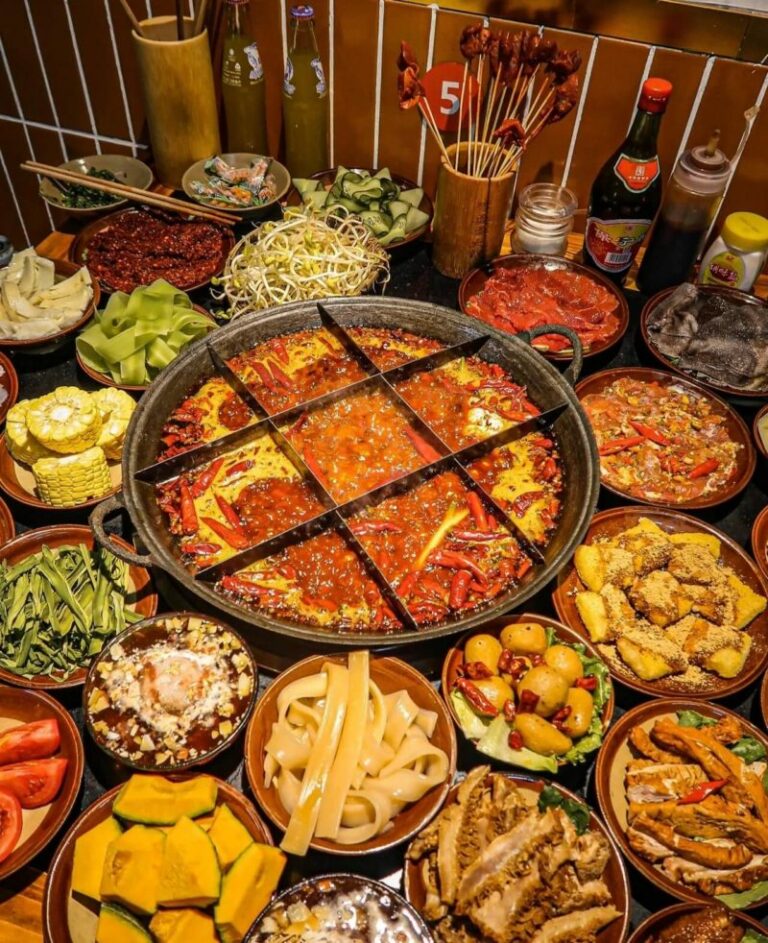
Image Source : CielChine
6. Yunnan Crossing the Bridge Noodles (米线)
Origin & History:
Crossing the Bridge Noodles, also known as “Guo Qiao Mi Xian” in Chinese, is a traditional dish from Yunnan province in southwestern China. The dish has a history dating back over 100 years and is deeply rooted in Yunnan’s culinary culture. The name “Crossing the Bridge Noodles” originates from a story about a wife who brought a daily meal to her husband, a scholar studying for exams on a small island. To keep the noodles warm and prevent them from becoming soggy, she separated the ingredients and combined them only when she crossed the bridge to the island. The dish has since become popular throughout China for its unique preparation and delicious flavors.
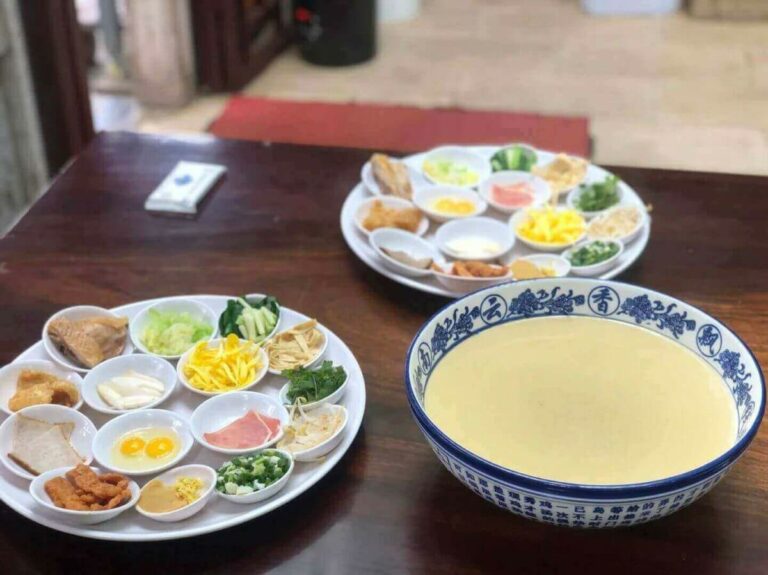
Image Source : CielYunnan
Features & Preparation:
Crossing the Bridge Noodles is known for its rich and flavorful broth, delicate rice noodles, and an assortment of toppings that include thinly sliced meats, vegetables, and herbs. The dish is traditionally served with the ingredients separated, allowing diners to combine them just before eating to maintain the optimal texture and taste.
To prepare Crossing the Bridge Noodles, start by making a flavorful broth. Simmer chicken or pork bones, along with spices such as star anise, cinnamon, and ginger, for several hours until a rich and aromatic broth is achieved. Strain the broth and keep it hot.
Prepare the toppings by thinly slicing meats such as chicken, pork, or fish. Blanch vegetables like bean sprouts, spinach, or bok choy, and prepare herbs such as cilantro or green onions. Cook the rice noodles according to the package instructions, ensuring they remain al dente.
To serve Crossing the Bridge Noodles, pour the hot broth into a large bowl. Arrange the cooked rice noodles, sliced meats, blanched vegetables, and herbs on a separate plate. When ready to eat, add the meats to the hot broth first, allowing them to cook briefly. Follow with the vegetables, herbs, and finally, the rice noodles. Stir the ingredients together, allowing the flavors to meld and the noodles to absorb the rich broth.
Crossing the Bridge Noodles is a comforting and customizable dish, perfect for enjoying on a chilly day or as part of a larger Chinese meal. Share this traditional Yunnan dish with friends and family, appreciating its unique preparation and the story behind its name.
Another way to make rice noodles: Small Pot Rice Noodles
7. Kung Pao Chicken (宫保鸡丁)
Origin & History:
Kung Pao Chicken is a classic Chinese dish that originated in the Sichuan Province of China. It is named after Ding Baozhen, a Qing Dynasty official who was known by the title “Kung Pao,” which means “Palace Guardian” in English. Ding Baozhen loved this spicy chicken dish so much that it became associated with his title, and thus the name “Kung Pao Chicken” was born.
Features & Preparation:
Kung Pao Chicken is known for its bold flavors, combining spicy, sweet, and savory elements in perfect harmony. The dish features tender pieces of chicken that are stir-fried with a mixture of vegetables, such as bell peppers, onions, and zucchini, as well as peanuts or cashews for added crunch. The dish is brought to life with a spicy sauce made from soy sauce, hoisin sauce, sugar, and Sichuan peppercorns, which provide the characteristic numbing heat associated with Sichuan cuisine.
To prepare Kung Pao Chicken, marinate the diced chicken in soy sauce, cornstarch, and rice wine for a short time. Then, heat oil in a wok or large frying pan and stir-fry the chicken until cooked through. Remove the chicken from the pan and set aside. Next, stir-fry the vegetables and nuts in the same pan until they are tender-crisp. Return the cooked chicken to the pan and add the sauce, which has been prepared by mixing soy sauce, hoisin sauce, sugar, Sichuan peppercorns, and any additional spices or flavorings desired. Cook the mixture until the sauce thickens and coats the chicken and vegetables evenly. Kung Pao Chicken is typically served over steamed white or brown rice, making it a satisfying and flavorful meal.
8. Boiled Beef Slices in Chili Oil (水煮肉片)
Origin & History:
Boiled Beef Slices in Chili Oil, also known as “Shuizhu Niurou” in Chinese, is a traditional and popular dish from Sichuan Province, China. The dish is famous for its pungent and spicy flavors, which are characteristic of Sichuan cuisine. It is believed that the dish originated in the Qing Dynasty, as a variation of the classic Sichuan “water-boiled” cooking technique. Over time, the dish has spread throughout China and gained a reputation for its delicious taste and fiery heat.
Features & Preparation:
Boiled Beef Slices in Chili Oil is celebrated for its intense flavors and tender, succulent beef. The dish is prepared by boiling thinly sliced beef in a flavorful broth, which is then poured over a bed of vegetables, such as bean sprouts and Napa cabbage. The dish is finished with a generous amount of chili oil, Sichuan peppercorns, and other spices, which create a mouthwatering aroma and a spicy, numbing sensation on the palate.
To prepare Boiled Beef Slices in Chili Oil, begin by marinating thinly sliced beef in a mixture of soy sauce, rice wine, and cornstarch. While the beef is marinating, prepare the vegetables by washing and cutting them into bite-sized pieces. In a large pot, bring a flavorful broth to a boil, which can be made from chicken or beef stock, ginger, garlic, and various seasonings. Add the marinated beef slices to the boiling broth and cook until just done, being careful not to overcook them.
In a separate pan, heat a generous amount of chili oil and fry a mixture of dried red chilies, Sichuan peppercorns, and minced garlic until fragrant. Place the cooked vegetables in a serving dish, and layer the cooked beef slices on top. Pour the hot chili oil mixture over the beef and vegetables, and garnish with chopped green onions and cilantro.
Boiled Beef Slices in Chili Oil is typically served with steamed white or brown rice to help balance the dish’s intense flavors. Enjoy this delicious and spicy Sichuan dish as part of a larger Chinese meal, sharing the heat and bold flavors with friends and family.
9. Dim Sum (点心)
Origin & History:
Dim Sum, also known as “Dian Xin” in Chinese, is a traditional Chinese cuisine consisting of a variety of bite-sized dishes typically served with tea. Originating in southern China, particularly in Guangdong province, the custom of eating Dim Sum is thought to have begun in teahouses along the ancient Silk Road where travelers would stop to rest and enjoy tea accompanied by small dishes. Over time, the tradition spread throughout China and later around the world, becoming a popular dining experience with countless variations of these delicate dishes.
Features & Preparation:
Dim Sum dishes are characterized by their small size and wide variety, ranging from savory dumplings, buns, and rolls to sweet pastries and tarts. Common ingredients used in Dim Sum include meat, seafood, vegetables, and rice flour, with each dish meticulously prepared using various cooking techniques, such as steaming, frying, and baking.
To prepare Dim Sum, first decide on the types of dishes you wish to serve. Popular options include Har Gow (shrimp dumplings), Siu Mai (pork and shrimp dumplings), Cha Siu Bao (barbecue pork buns), and egg tarts. Each dish requires a specific set of ingredients and preparation techniques, so it’s essential to gather the necessary components and follow detailed recipes for each item.
For example, to make Har Gow, combine finely chopped shrimp with seasonings like salt, sugar, sesame oil, and cornstarch to create the filling. Prepare a dough made from wheat starch, tapioca starch, and boiling water. Shape the dough into small, thin circles, add a spoonful of the shrimp filling, and carefully fold and pleat the edges to create a half-moon shape. Steam the dumplings in a bamboo steamer for several minutes until the dough becomes translucent and the shrimp filling is cooked.
Dim Sum is best enjoyed with friends or family, as the dishes are meant to be shared and savored in a leisurely manner. Accompanied by tea, the experience becomes a social gathering that showcases the art and skill of Chinese culinary tradition.
10. Shredded Pork in Garlic Sauce (鱼香肉丝)
Origin & History:
Shredded Pork in Garlic Sauce, also known as “Yuxiang Rousi” in Chinese, is a classic and popular Sichuan dish. The name “Yuxiang” translates to “fish fragrance” in English; however, the dish does not contain any fish. Instead, the term refers to the combination of flavors traditionally used in Sichuan fish dishes, which are also used in this pork dish. The dish is believed to have originated during the Qing Dynasty and has since become a staple in Sichuan cuisine, enjoyed by people both in China and around the world.
Features & Preparation:
Shredded Pork in Garlic Sauce is known for its unique and harmonious blend of flavors, combining sweet, sour, spicy, and savory elements. The dish features thinly sliced pork, which is stir-fried with vegetables such as bamboo shoots, bell peppers, and wood ear mushrooms, creating a delightful medley of textures. The flavorful sauce is made from a combination of ingredients, including soy sauce, vinegar, sugar, garlic, ginger, and chili paste, which give the dish its characteristic taste.
To prepare Shredded Pork in Garlic Sauce, begin by marinating thinly sliced pork in a mixture of soy sauce, cornstarch, and rice wine. While the pork is marinating, prepare the vegetables by washing and slicing them into thin strips. In a small bowl, combine the sauce ingredients, such as soy sauce, vinegar, sugar, garlic, ginger, and chili paste, and set aside.
Heat oil in a wok or large frying pan and stir-fry the marinated pork until cooked through. Remove the pork from the pan and set aside. In the same pan, stir-fry the vegetables until they are tender-crisp. Return the cooked pork to the pan and add the sauce, cooking until the sauce thickens and evenly coats the pork and vegetables.
11. Buddha Jumps Over the Wall (佛跳墙)
Origin & History:
Buddha Jumps Over the Wall, also known as “Fo Tiao Qiang” in Chinese, is a luxurious and famous dish originating from the Fujian province of China. It is said to have been created during the Qing Dynasty, and the dish has a rich history and cultural significance. The name is derived from a story about a Buddhist monk who, upon smelling the dish’s irresistible aroma, abandoned his vegetarian diet and leaped over the temple wall to partake in the meal. This dish is renowned for its exquisite taste, complex flavors, and the use of premium ingredients.
Features & Preparation:
Buddha Jumps Over the Wall is a soup known for its rich and savory flavors, and it features a variety of high-quality ingredients, such as abalone, sea cucumber, shark’s fin, fish maw, scallops, Chinese mushrooms, Jinhua ham, quail eggs, and chicken. The dish is prepared by simmering these ingredients in a fragrant broth made from chicken, pork bones, and various Chinese herbs. The cooking process is slow and meticulous, often taking more than 24 hours, which allows the flavors to meld and the ingredients to become tender and succulent.
To prepare Buddha Jumps Over the Wall, begin by soaking the dried ingredients, such as sea cucumber, fish maw, scallops, and mushrooms, in water until they are fully rehydrated. Clean and prepare the remaining ingredients, such as abalone, Jinhua ham, quail eggs, and chicken. In a large pot, create a flavorful broth by simmering chicken, pork bones, and a variety of Chinese herbs, such as goji berries, red dates, and dried longan. Cook the broth for several hours, allowing the flavors to develop and deepen.
Once the broth is ready, strain it to remove any solids, and return it to the pot. Add the prepared ingredients, such as abalone, sea cucumber, shark’s fin, fish maw, scallops, Chinese mushrooms, Jinhua ham, quail eggs, and chicken, to the broth. Simmer the soup at a low heat for several more hours, allowing the ingredients to become tender and absorb the rich flavors of the broth.
Buddha Jumps Over the Wall is typically served in a large, decorative bowl or clay pot, and it is often enjoyed as part of a special occasion or festive celebration. Savor the dish’s exquisite taste and the harmonious blend of flavors, which showcase the best of Chinese cuisine.
12. Sour and Spicy Fish (酸菜鱼)
Origin & History:
Sour and Spicy Fish, also known as “Suan La Yu” in Chinese, is a popular dish with roots in the Chongqing region of China, which is known for its spicy and bold flavors. The dish has gained popularity throughout China and has become a beloved choice for those seeking a unique and flavorful seafood experience. Sour and Spicy Fish showcases the harmonious balance of flavors found in Chinese cuisine, combining sour, spicy, and savory elements to create a mouthwatering dish.
Features & Preparation:
Sour and Spicy Fish is celebrated for its tender, flaky fish and its complex and enticing sauce. The dish typically features a whole fish, such as carp or catfish, which is cooked in a tangy, spicy broth made from ingredients like pickled chili peppers, vinegar, ginger, garlic, and various seasonings. The broth is thickened with cornstarch, creating a rich and velvety sauce that clings to the fish and enhances its natural flavors. The dish is often garnished with fresh herbs, such as cilantro or green onions, adding a burst of freshness and color to the presentation.
To prepare Sour and Spicy Fish, begin by cleaning and descaling the fish, removing the head and tail if desired. Score the fish on both sides to ensure even cooking and better absorption of flavors. In a large pot or wok, heat oil and stir-fry a mixture of pickled chili peppers, ginger, and garlic until fragrant. Add water or chicken broth, along with vinegar, sugar, and other seasonings, to create the tangy and spicy broth.
Gently lower the fish into the simmering broth and cook until the fish is cooked through and easily flakes with a fork. In a separate bowl, combine cornstarch and water to form a slurry, and gradually pour it into the broth, stirring constantly until the sauce thickens. Once the sauce reaches the desired consistency, carefully transfer the cooked fish to a serving platter and pour the thickened sauce over the fish. Garnish with fresh herbs, such as cilantro or green onions, before serving.
Sour and Spicy Fish is typically served with steamed white or brown rice, which helps to balance the bold flavors of the dish. Enjoy this delicious and satisfying seafood dish as part of a larger Chinese meal, sharing its unique flavors and textures with friends and family.
13. Yunnan-style Fried Potato Strips (云南干煸土豆丝)
Origin & History:
Yunnan-style Fried Potato Strips is a traditional Yunnanese dish made primarily of potatoes. It is believed that the dish originated during the construction of the Yunnan-Vietnam Railway, which connected China’s Yunnan Province to Ho Chi Minh City in Vietnam. The railway was built between 1904 and 1910 and was an important engineering project in Chinese history, providing an important transportation link for trade and communication between Yunnan and Vietnam. During the construction process, French culture and cuisine were introduced to Yunnan, and Yunnan-style Fried Potato Strips became a popular dish in China.
Features & Preparation:
Yunnan-style Fried Potato Strips is a dish that is easy to prepare. The potatoes are cut into thin strips and then stir-fried in a wok with oil, garlic, ginger, and dried chili peppers until they turn golden and crispy. Finally, salt, Sichuan pepper, and scallions are added for seasoning.
Yunnan-style Fried Potato Strips can be served as a snack or a side dish. Its crispy texture and rich aroma are irresistible to many.

Image Source : CielYunnan
14. Fried Noodles (炒面)
Origin & History:
Fried Noodles, also known as “Chao Mian” in Chinese, is a classic and versatile dish found in various forms throughout China and other Asian countries. The dish is believed to have originated in the Han Dynasty and has since become a popular staple in Chinese cuisine. Fried noodles are known for their adaptable nature, as they can be prepared with a wide range of ingredients and flavors, making them a favorite for both home cooks and professional chefs alike.
Features & Preparation:
Fried Noodles are celebrated for their satisfying texture and the endless variety of flavors and ingredients they can be paired with. The dish typically features egg or wheat noodles, which are stir-fried with a mix of vegetables, proteins, and seasonings. Common proteins include chicken, pork, beef, shrimp, or tofu, while vegetables can range from bell peppers and onions to bean sprouts and bok choy. The dish is seasoned with a combination of sauces and spices, such as soy sauce, oyster sauce, sesame oil, and garlic, which create a flavorful and aromatic dish.
To prepare Fried Noodles, begin by cooking the noodles according to the package instructions, being careful not to overcook them. Rinse the cooked noodles under cold water to stop the cooking process and to remove any excess starch. Set the noodles aside.
In a wok or large frying pan, heat a small amount of oil over high heat. Stir-fry the protein of your choice, such as chicken, pork, beef, shrimp, or tofu, until cooked through. Remove the protein from the wok and set aside. Add more oil if necessary, and stir-fry the vegetables until they are tender-crisp.
Return the cooked protein to the wok, along with the cooked noodles. Add the sauces and seasonings, such as soy sauce, oyster sauce, sesame oil, and garlic, stirring to ensure the ingredients are evenly coated and the flavors meld together. Cook for a few more minutes, allowing the noodles to absorb the flavors and develop a slightly crispy texture.
Serve Fried Noodles as a main course or alongside other Chinese dishes. Garnish with green onions, sesame seeds, or chopped cilantro if desired. Enjoy this classic and customizable Chinese dish, experimenting with different ingredients and flavors to create your perfect version of Fried Noodles. Share this delicious and satisfying meal with friends and family, appreciating its versatility and rich history.
15. Spring Rolls (春卷)
Origin & History:
Spring Rolls, also known as “Chun Juan” in Chinese, are a popular and traditional appetizer originating from China. The dish is believed to have first appeared during the Eastern Jin Dynasty (around 265-420 AD) and was initially consumed during the Spring Festival, hence the name “Spring Rolls.” Over time, these crispy and delicious rolls have become a popular dish not only in China but also in various Asian countries, each with their own regional variations.
Features & Preparation:
Spring Rolls are known for their crispy, golden exterior and flavorful, savory filling. The dish typically features a thin, delicate wrapper made from wheat flour, which is filled with a variety of ingredients such as shredded vegetables, cooked meat (such as chicken, pork, or shrimp), and glass noodles. Spring rolls are seasoned with soy sauce, garlic, and other spices, which add depth and flavor to the filling.
To prepare Spring Rolls, start by preparing the filling. In a wok or large frying pan, heat a small amount of oil and stir-fry the chosen vegetables, such as shredded cabbage, carrots, and bean sprouts, until they are tender-crisp. Add cooked meat or seafood, if desired, and season the mixture with soy sauce, garlic, and other spices. Cook the filling until the ingredients are well combined and the flavors have melded together. Allow the filling to cool slightly before assembling the spring rolls.
To assemble the Spring Rolls, place a small amount of the prepared filling on the lower third of a spring roll wrapper. Fold the bottom edge of the wrapper over the filling, tucking it in tightly. Fold in the sides of the wrapper and continue to roll it up, sealing the edge with a bit of water or a mixture of water and cornstarch.
To cook the Spring Rolls, heat oil in a deep fryer or heavy-bottomed pot to 350°F (175°C). Carefully lower the spring rolls into the hot oil and fry them until they are golden brown and crispy, turning occasionally to ensure even cooking. Remove the cooked spring rolls from the oil and drain them on paper towels to remove any excess oil.
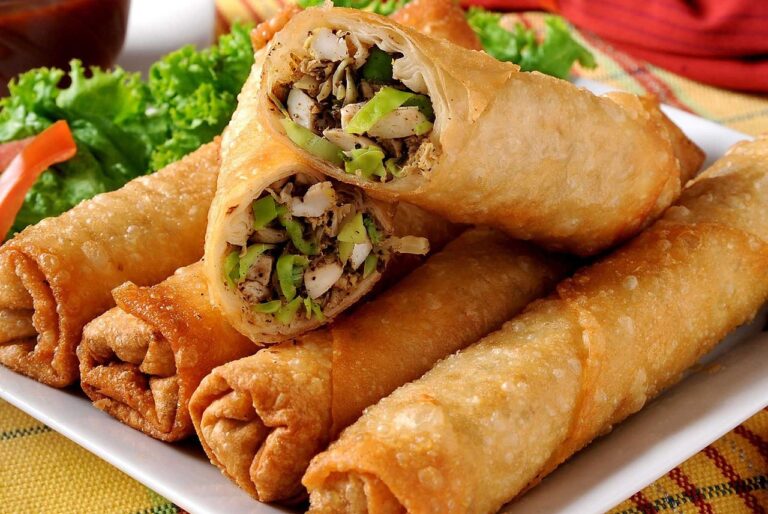
16. Boiled Dumpling (水饺)
Origin & History:
Boiled Dumplings, known as “Shui Jiao” in Chinese, are a traditional and beloved dish in Chinese cuisine. They are said to have originated during the Han Dynasty (around 206 BC – 220 AD) and were popularized by Zhang Zhongjing, a famous Chinese medical scientist and philosopher. Dumplings are typically consumed during the Chinese New Year and other important festivals, symbolizing prosperity and family unity. Over time, dumplings have become a staple in Chinese households and restaurants, enjoyed by people all over the world.
Features & Preparation:
Boiled Dumplings are celebrated for their tender and delicate wrappers, which encase a variety of flavorful and savory fillings. The fillings typically consist of minced meat (such as pork, beef, or chicken), chopped vegetables (such as cabbage, chives, or mushrooms), and seasonings like soy sauce, ginger, and garlic. The dumplings are boiled in water, giving them a soft and tender texture.
To prepare Boiled Dumplings, begin by making the dough for the wrappers. Combine all-purpose flour with water and knead the mixture until a smooth, elastic dough forms. Allow the dough to rest for at least 30 minutes, which will make it easier to roll out.
While the dough is resting, prepare the filling by mixing together the chosen minced meat, chopped vegetables, and seasonings. Adjust the flavor as desired, adding more soy sauce, ginger, or garlic to taste.
After the dough has rested, roll it out on a lightly floured surface to a thin sheet. Use a round cookie cutter or the rim of a glass to cut out circular wrappers. Place a small amount of filling in the center of each wrapper, being careful not to overfill them. Fold the wrapper in half and seal the edges, creating a pleated or pinched pattern to ensure the filling stays securely inside the dumpling.
To cook the Boiled Dumplings, bring a large pot of water to a boil. Carefully add the dumplings to the boiling water, stirring gently to prevent them from sticking to the bottom of the pot. Cook the dumplings until they float to the surface and the wrappers become slightly translucent, indicating they are cooked through.
Serve Boiled Dumplings hot, accompanied by dipping sauces such as soy sauce, black vinegar, or chili oil.
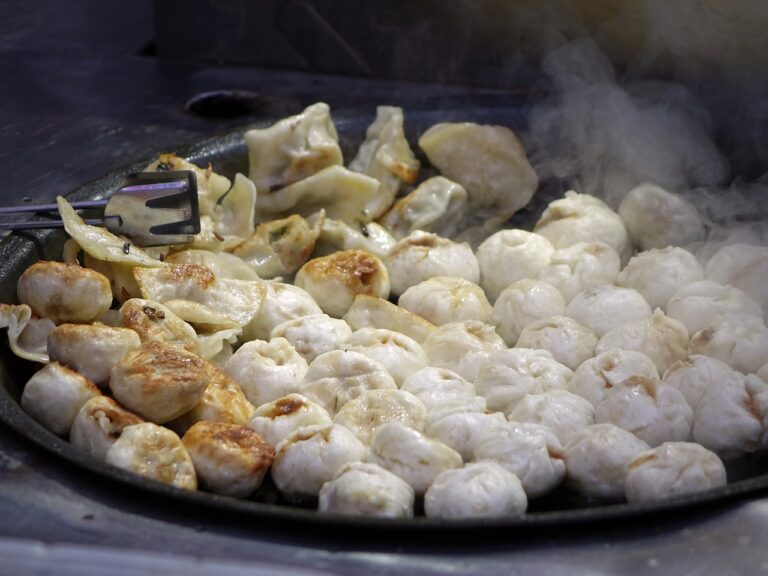
17. Bubble Tea (珍珠奶茶)
Origin & History:
Bubble Tea, also known as “Zhen Zhu Nai Cha” or “Pearl Milk Tea” in Chinese, is a popular beverage that originated in Taiwan in the 1980s. It was created in Taichung City by Liu Han-Chieh, who started adding fruit syrup to his tea, and then in Tainan City by Tu Tsong-He, who added tapioca pearls to his milk tea. The drink quickly gained popularity in Taiwan and later spread throughout Asia and the rest of the world.
Features & Preparation:
Bubble Tea is characterized by its combination of brewed tea, milk or creamer, sweetener, and chewy tapioca pearls, which are also known as “boba” or “pearls.” The drink can be served either hot or cold and comes in a wide variety of flavors, ranging from classic black or green tea to fruit-flavored or even coffee-based options. The beverage is typically shaken or stirred, creating a frothy, bubbly texture that gives the drink its name.
To prepare Bubble Tea, begin by cooking the tapioca pearls according to the package instructions. The pearls should be soft and chewy with a slightly sweet taste. Set the cooked pearls aside and allow them to cool.
Next, brew the tea of your choice (such as black, green, or oolong tea) and let it cool to room temperature. In a shaker or large glass, combine the brewed tea with milk, creamer, or a dairy-free alternative, as well as a sweetener like sugar or honey. Adjust the proportions to your taste preferences.
Fill a glass with ice and add a scoop of the cooked tapioca pearls to the bottom. Pour the tea mixture over the ice and pearls, stirring or shaking the drink to ensure it is well combined and frothy.
Serve Bubble Tea with a thick straw, which allows you to enjoy both the refreshing tea and the chewy tapioca pearls simultaneously. Experiment with different tea and flavor combinations, creating your own unique and delicious Bubble Tea concoctions to share with friends and family.
18. Steamed Soup Dumplings (小笼包)
Origin & History:
Xiaolongbao, also known as soup dumplings, is a type of steamed bun filled with meat and soup, which originated in Shanghai, China during the late Qing Dynasty. The precise origin of Xiaolongbao is uncertain, but it is believed to have been created by street vendors who were looking for a way to make their steamed buns more flavorful and satisfying. The dish became popular in Shanghai in the early 20th century and spread throughout China and beyond in the decades that followed.
Features & Preparation:
Xiaolongbao is characterized by its thin, delicate skin and savory filling, which typically consists of minced pork or other meats, as well as a savory broth or soup. The soup is created by adding gelatinous meat stock to the filling mixture, which turns into soup when the dumplings are steamed.
To make Xiaolongbao, a dough made from wheat flour and water is rolled out into thin sheets, and small circles of dough are cut out. A small amount of filling is placed in the center of each dough circle, and the edges are pinched together to seal the filling inside. The dumplings are then steamed in a bamboo basket over boiling water, which causes the soup inside the dumplings to become hot and liquid.
Xiaolongbao is traditionally served with black vinegar and slivers of ginger, which are used to enhance the flavor of the dumplings. They are typically eaten as a snack or appetizer and are often accompanied by other dim sum dishes.
19. Lanzhou Beef Noodle Soup (兰州拉面)
Origin & History:
Lanzhou Beef Noodle Soup is a famous traditional dish from Lanzhou, a city in Gansu Province, China. It is said that the dish originated during the Qing Dynasty and was perfected by a man named Ma Baozi. The soup is made from slow-cooked beef bones and a special blend of spices, which gives it a rich and flavorful taste. The noodles are hand-pulled and served with slices of tender beef, green onions, and other seasonings. Today, Lanzhou Beef Noodle Soup is enjoyed throughout China and has become a popular street food in many cities.
Features & Preparation :
Lanzhou Beef Noodle Soup is known for its rich, savory broth and tender, flavorful beef. The noodles are also a standout feature, as they are handmade and have a satisfyingly chewy texture. The soup is typically served with a variety of toppings, such as green onions, cilantro, chili oil, and pickled vegetables, which add depth and complexity to the dish.
To make Lanzhou Beef Noodle Soup, beef bones are simmered for hours to create a flavorful broth. The broth is then strained and combined with a blend of spices, including ginger, garlic, and star anise. The beef is thinly sliced and added to the broth, along with the handmade noodles, which are boiled until cooked through. The soup is typically served in a large bowl, with the toppings arranged on top of the noodles.
20. Century Egg (皮蛋)
Origin & History:
Century Egg, also known as preserved egg or thousand-year egg, is a Chinese delicacy that has been enjoyed for centuries. Its exact origin is not known, but it is believed to have been invented during the Ming Dynasty (1368-1644) in China. The process of preserving eggs using a mixture of clay, ash, salt, quicklime, and rice straw was developed as a way to preserve eggs for longer periods of time, particularly during times of food scarcity. The eggs were first used as a source of protein by the rural population, but eventually became a popular delicacy in Chinese cuisine. Today, Century Egg is widely enjoyed throughout China and has also gained popularity in other parts of the world, particularly in Southeast Asia.
Features & Preparation:
The preservation process transforms the egg white into a gelatinous substance and turns the yolk into a creamy, dark green color. The egg has a pungent aroma and a unique, rich flavor that is often described as savory and salty with a slightly sweet aftertaste.
To prepare Century Egg, the preserved egg is typically sliced and served as a side dish or used as a topping for porridge, noodles, or congee. It can also be mashed and mixed with tofu or used as a filling for steamed buns or dumplings. The egg’s unique flavor makes it a popular ingredient in many Chinese dishes, including salads, soups, and stir-fries. Some people also enjoy eating Century Egg on its own, often with a drizzle of vinegar or soy sauce to enhance the flavor.
Conclusion
China’s diverse culinary landscape is a testament to its rich regional and ethnic diversity. The vast country boasts an impressive array of distinct cuisines, each reflecting the unique flavors, ingredients, and traditions of its respective area and people. This multitude of gastronomic experiences results from the intricate interplay of geography, climate, history, and local customs, giving rise to a spectacular tapestry of culinary delights. As you travel through China, you’ll encounter a fascinating blend of flavors and techniques, where each region and ethnic group contributes their own signature dishes and culinary heritage, making Chinese cuisine an extraordinary journey for the senses.
Discover the captivating flavors of China’s culinary treasures by embarking on an unforgettable food journey! The best way to explore the diverse and mouthwatering cuisine is by experiencing it firsthand in its home country. Don’t hesitate to contact us – we’re eager to help you plan the ultimate gastronomic adventure throughout China, where you’ll savor authentic dishes and create lasting memories. Your taste buds will thank you.
